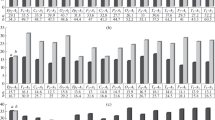Abstract
The psychosocial and physical factors, including chemical ones, which affect the human organism are considered by some authors to be stress factors which affect the functional state (FS) of the central nervous system (CNS). We calculated correlations among the clinical, psychological/psychometric, and quantitative electropsychological (QEEG) variables of the functional changes of the CNS in chemical stress. These data were based on occupational contact with lead as experienced by 402 workers, with styrene by 96, with shale-oil products by 252, with organic solvents by 77 workers, and a control group of 145 workers in different age groups. The QEEG data of 77 patients were analyzed to determine the chronic neurotoxic effects of industrial chemical substances by diagnosing the functional changes at the syndrome level. We concluded that occupational chemical factors impact the functional state of the CNS. During chemical stress α-activity and total cerebral bioelectrical activity (BA) decreases. The use of psychometric/ psychological and QEEG methods makes it possible to diagnose the changes of the CNS as hypersthenic, hyposthenic, and organic psychosyndromes.
Similar content being viewed by others
References
Anokhin, P. K. (1973).Principles of the theory of functional systems. Moscow: Nauka.
Ashby, R. (1963).Design for a brain. London: Chapman Hall Ltd.
Hartman, D. E. (1988).Neuropsychological toxicology. New York: Pergamon Press.
Hoolma, M., & Petersen, I. (1981).Computer analysis of data. Tallinn: Valgus.
Kubat, J. (1988). EEG, as a neurotoxicological indicator.Toxicology, 49, 237–246.
Lehmann, D. (1980). Fluctuations of functional states: EEG patterns and perceptional cognitive strategies.Functional states of the brain. Amsterdam: Elsevier.
Lindström, K., & Mäntusalo, S. (1987). Physical and chemical factors that increase vulnerability to stress and act as stressors at work.Psychosocial Factors at Work, 3, 112–123.
Livanov, M. N., Russinoff, V. S., Simonov, P. V., et al. (1988).Diagnosis and prognosis of the functional state of the human brain. Moscow: Medicina.
Lopes de Silva, F. H., Vas, Y., Mooibrock, J., & Van Rotterdam, A..Partial coherence analysis of thalamic and cortical alpha rhythms in dog—a contribution towards a general model of the cortical organization of rhythmic activity.Rhythmic EEG activities and cortical functioning. Amsterdam: Elsevier.
Luria, A. R. (1973).The functioning brain. New York: Basic Books.
O'Hanlon, J. F. (1978). Neurophysiological reactions to stress: Psychosocial, physical and chemical stressor at work.Scandinavian Journal of Psychology, 12, 157–159.
Rissinoff, V. S. (1987).The bioelectrical potential of the human brain. Moscow: Medicina.
Selye, H. (1950).The physiology and pathology of exposure to stress. Montreal: Acta Inc. Med. Publ.
Styblova, V. (1977). Electroencephalographie in der diagnostik der frühhirnschädigung durch schwefelkohlenstoff.International Archives of Occupational Environmental Health, 38, 262–297.
Valciucas, J., & Lilis, R. (1980). Psychometric techniques in environmental research.Environmental Research, 21, 275–297.
Walter, D. (1965). Mathematical analysis of EEG generation progresses.EEG and Clinical Neurophysiology, 18, 533.
Author information
Authors and Affiliations
Rights and permissions
About this article
Cite this article
Tuulik, V. The functional state of the central nervous system in chemical stress. Int J Stress Manage 3, 107–115 (1996). https://doi.org/10.1007/BF01857719
Issue Date:
DOI: https://doi.org/10.1007/BF01857719



